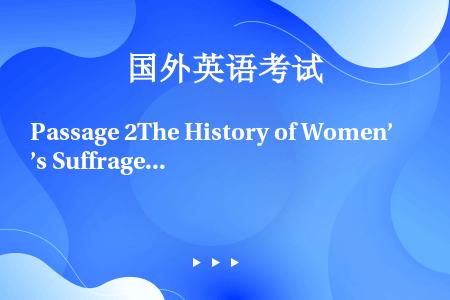 问答题
问答题
Passage 2The History of Women’s Suffrage A In the early nineteenth century, women were considered second-class citizens whose existence was limited to the interior life of the home and care of the children. Women were considered subsets of their husbands, and after marriage they did not have the right to own property, maintain their wages, or sign a contract, much less vote. It was expected that women be obedient wives, never to hold a thought or opinion independent of their husbands. It was considered improper for women to travel alone or to speak in public. With the belief that intense physical or intellectual activity would be injurious to the delicate female biology and reproductive system, women were taught to refrain from pursuing any serious education. Silently perched in their birdcages, women were considered merely objects of beauty, and were looked upon as intellectually and physically inferior to men. This belief in women’s inferiority to men was further reinforced by organized religion which preached strict and well-defined sex roles. B The Seneca Falls Convention The women’s suffrage movement was formally set into motion in 1848 with the first Women’s Rights Convention in Seneca Falls, New York. The catalyst for this gathering was the World Anti-Slavery Convention held in 1840 in London and attended by an American delegation which included a number of women. In attendance were Lucretia Mort and Elizabeth Cady Stanton, who were forced to sit in the galleries as observers because they were women. This poor treatment did not rest well with these women of progressive thoughts, and it was decided that they would hold their own convention to “discuss the social, civil and religious rights of women”. Using The Declaration of Independence as a guideline, Stanton presented her Declaration of Principles in her hometown chapel and brought to light women’s subordinate status and made recommendations for change. Resolution 9 requesting the right to vote was perhaps the most important in that it expressed the demand for sexual equality. Subsequent to the Seneca Falls Convention, the demand for the vote became the centerpiece of the women’s rights movement. C Suffrage During the Civil War During the Civil War, women’s suffrage was eclipsed by the war effort and movement for the abolition of slavery. While annual conventions were held on a regular basis, there was much discussion but little action. Activists such as slave-born Sojourner Truth, Elizabeth Stanton, and Susan B. Anthony lectured and petitioned the government for the emancipation of slaves with the belief that, once the war was over, women and slaves alike would be granted the same rights as the white men. At the end of the war, however, the government saw the suffrage of women and that of the negro as two separate issues and it was decided that the negro vote could produce the immediate political gain, particularly in the South, that the women’s vote could not. Abraham Lincoln declared, “This hour belongs to the negro.” D Women Unite With the side-stepping of women’s rights, women activists became enraged, and the American Equal Rights Association was established by Stanton and her colleagues in 1866 in effort to organize in the fight for women’s rights. In 1868, the ratification of the Fourteenth Amendment proved an affront to the women’s movement, as it defined “citizenship” and “voters” as “male”, and raised the question as to whether women were considered citizens of the United States at all. The exclusion of women was further reinforced with the ratification of the Fifteenth Amendment in 1870, which enfranchised black men. In a disagreement over these Amendments, the women’s movement split into two factions. In New York, Stanton and Anthony established the radical National Woman Suffrage Association (NWSA). Lucy Stone, Julia Ward Howe, and Henry Blackwell organized the more conservative American Woman Suffrage Association (AWSA) in Boston. These two groups later merged in 1890 to form the National American Woman Suffrage Association (NAWSA) under the leadership of Elizabeth Cady Stanton. E Winning the Vote Susan B. Anthony was arrested for attempting to vote for Ulysses S. Grant in the 1872 presidential election. Six years later, in 1878, a Women’s Suffrage Amendment was introduced to U.S. Congress. With the formation of numerous groups, such as the Women’s Christian Temperance Union (WCTU), the National Council of Jewish Women (NCJW), the National Association of Colored Women (NACW) and, the Women’s Trade Union League, the women’s movement gained a full head of steam during the 1890’s and early 1900’s. The U.S. involvement in World War I in 1918 slowed down the suffrage campaign as women pitched in for the war effort. However, in 1919, after years of petitioning, picketing, and protest parades, the Nineteenth Amendment was passed by both houses of Congress and in 1920 it became ratified under the presidency of Woodrow Wilson. F Amendment xix 1. The right of citizens of the United States to vote shall not be denied or abridged by the United States or by any State on account of sex. 2. Congress shall have power to enforce this Article by appropriate legislation. (Ratified August 26, 1920) G Equal Rights Amendment Upon this victory of the vote, the NAWSA disbanded as an organization, giving birth to the League of Women Voters. The vote was not enough to secure women’s equal rights according to Alice Paul, founder of the National Woman’s Party (NWP), who moved to take women’s rights one step further by proposing the Equal Rights Amendment (E.R.A.) to Congress in 1923. This demand to eliminate discrimination on the basis of gender failed to pass. The push for the E.R.A. continued on a state-by-state basis, until the newly formed National Organization for Women (NOW) launched a national campaign during the 1960’s. Despite many heated debates and protests, the E.R.A., while passed by Congress in 1972, has never been ratified. Do the following statements agree with the information given in Reading Passage 2? In boxes 1-6 on your answer sheet, write TRUE if the statement agrees with the information FALSE if the statement contradicts the information NOT GIVEN if there is no information on this 1. In the early nineteenth century it was generally believed that men and women performed different roles in society. 2. The World Anti-Slavery Convention preceded the first Women’s Right Convention. 3. During the American Civil War, the Women’s suffrage movement flourished. 4. Men were not allowed to join the National Woman Suffrage Association. 5. The National Woman Suffrage Association (NWSA) was less radical than the American Woman Suffrage Association (AWSA). 6. Abraham Lincoln was not sympathetic to the women’s movement.
发布日期:2022-07-04


题王网让考试变得更简单
扫码关注题王,更多免费功能准备上线!

此试题出现在
女,25岁,右肾结核行右肾切除,抗结核治疗半年多,尿痛缓解,但尿频加重,每晚7~8次,静脉尿路造影见左肾显影尚好,仅伴轻度肾积水及膀胱挛缩,尿常规白细胞0~2/HP,现治疗应选择()
商业银行对全部关联方的授信余额不得超过商业银行资本净额的()。
在政府危机公关中展开受害者群体分析,应以()为重点
大面积烧伤患者口渴时,可给予大量的开水口服。
患者,男性,40岁,在高温环境中强体力劳动后,先有大量出汗,然后四肢肌肉、腹壁肌肉阵发性痉挛和疼痛,遂来就诊。该患者入院后首先应做的辅助检查是()
在10Mb/s共享型以太网系统中,站点越多,带宽越窄。
1945年二战结束,盟军得以打败德国其中很关键的一个因素是,装备了有特别设计的()。
从事安全生产的工程技术人员和管理人员应重点熟悉()。
患者,男,36岁。平日性情急躁易怒,近日因工作不顺致失眠,不思饮食,口渴喜饮,口苦目赤,小便黄,大便秘结,舌红苔黄,脉弦数。其最佳治疗方剂为()
跟下疼痛,并沿跟骨内侧向前放散,跟骨结节跖面偏前方压痛()。
非专业可以考出版资格证书吗?有哪些报考条件?
关于BEC考试有哪些备考建议?
为什么要考BEC?
有哪些学习商务英语的好方法?
商务英语考试(BEC)难不难?
都说GRE考试难,那么它究竟难在哪?
什么是GRE考试?
雅思考试在即,如何快速备考?
说说雅思考试那些事
雅思5.5相当于CET几级的水平?
Passage 2The History of Women’s Suffrage A In the early nineteenth centur...
Passage 2The Ant Society Described as a “six-legged lliad”, Wilson’s Anthill dr...
Where were shells used as money in history?
Where were shells used as money in history?
Throughout their history, Americans have been people()the move.
History is the story of()happened to the people before today.
This is the world out of which grows the hope, for the first time in history, of...
Shakespeare’s plays fall into three categories.They are(),()and history plays.
How can an operator list all its history of commands in one step?()
The Norman Conquest is perhaps()event in English history.

